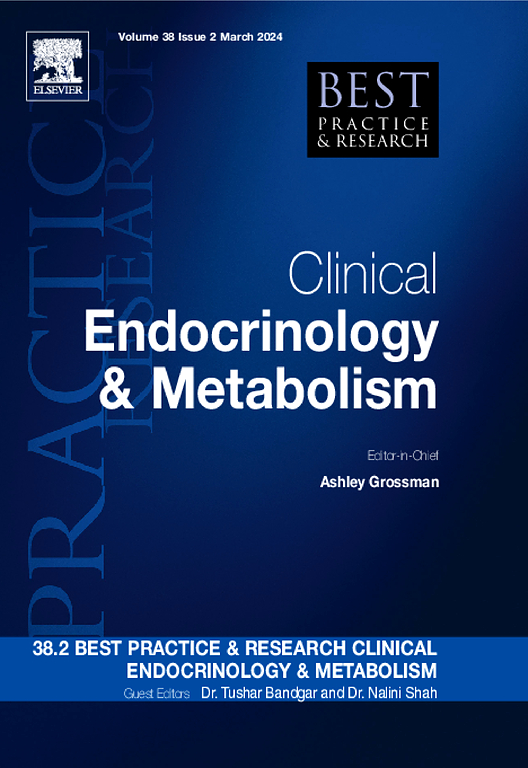Congenital primary hyperparathyroidism
IF 6.1
1区 医学
Q1 ENDOCRINOLOGY & METABOLISM
Best practice & research. Clinical endocrinology & metabolism
Pub Date : 2025-03-01
DOI:10.1016/j.beem.2025.101982
引用次数: 0
Abstract
Primary hyperparathyroidism is a constitutive excess of parathyroid hormone (PTH) in the blood, caused by an idiopathic defect of growth and/or function of the parathyroid glands. PHPT is usually an acquired disease, due to the sporadic development of parathyroid hyperplasia, adenoma, and, in extremely rare cases, malignant carcinoma, mainly occurring by the sixth decade of life. In about 5–10 % of cases PHPT manifests in the context of congenital disorders, having a genetic base and occurring much earlier in life, compared to the sporadic counterpart. Congenital PHPT can manifest as isolated PHPT or as syndromic PHPT in the context of complex multiorgan disorders. Non-syndromic inherited PHPT includes Familial Hypocalciuric Hypercalcemia types 1, 2 and 3, Neonatal Severe Primary Hyperparathyroidism, and three different genetic forms of Familial Isolated Hyperparathyroidism, while syndromic inherited PHPT includes Hyperparathyroidism-Jaw Tumor Syndrome and Multiple Endocrine Neoplasias types 1, 2 A and 4.
先天性原发性甲状旁腺功能亢进。
原发性甲状旁腺功能亢进是血液中甲状旁腺激素(PTH)的组成性过量,由甲状旁腺生长和/或功能的特发性缺陷引起。PHPT通常是一种获得性疾病,由于偶发的甲状旁腺增生,腺瘤,在极少数情况下,恶性癌,主要发生在60岁左右。在大约5- 10% 的病例中,PHPT表现为先天性疾病,具有遗传基础,与散发性疾病相比,发生的时间要早得多。先天性PHPT可以表现为孤立性PHPT,也可以表现为复杂多器官疾病背景下的综合征性PHPT。非综合征遗传性PHPT包括家族性低钙高钙血症1、2和3型、新生儿重度原发性甲状旁腺功能亢进症和三种不同遗传形式的家族性孤立性甲状旁腺功能亢进症,而综合征遗传性PHPT包括甲状旁腺功能亢进症-颌肿瘤综合征和多发性内分泌肿瘤1、2 A和4型。
本文章由计算机程序翻译,如有差异,请以英文原文为准。
求助全文
约1分钟内获得全文
求助全文
来源期刊
CiteScore
11.90
自引率
0.00%
发文量
77
审稿时长
6-12 weeks
期刊介绍:
Best Practice & Research Clinical Endocrinology & Metabolism is a serial publication that integrates the latest original research findings into evidence-based review articles. These articles aim to address key clinical issues related to diagnosis, treatment, and patient management.
Each issue adopts a problem-oriented approach, focusing on key questions and clearly outlining what is known while identifying areas for future research. Practical management strategies are described to facilitate application to individual patients. The series targets physicians in practice or training.

 求助内容:
求助内容: 应助结果提醒方式:
应助结果提醒方式:


